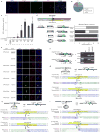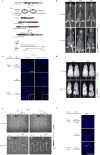In vivo genome editing via CRISPR/Cas9 mediated homology-independent targeted integration
- PMID: 27851729
- PMCID: PMC5331785
- DOI: 10.1038/nature20565
In vivo genome editing via CRISPR/Cas9 mediated homology-independent targeted integration
Abstract
Targeted genome editing via engineered nucleases is an exciting area of biomedical research and holds potential for clinical applications. Despite rapid advances in the field, in vivo targeted transgene integration is still infeasible because current tools are inefficient, especially for non-dividing cells, which compose most adult tissues. This poses a barrier for uncovering fundamental biological principles and developing treatments for a broad range of genetic disorders. Based on clustered regularly interspaced short palindromic repeat/Cas9 (CRISPR/Cas9) technology, here we devise a homology-independent targeted integration (HITI) strategy, which allows for robust DNA knock-in in both dividing and non-dividing cells in vitro and, more importantly, in vivo (for example, in neurons of postnatal mammals). As a proof of concept of its therapeutic potential, we demonstrate the efficacy of HITI in improving visual function using a rat model of the retinal degeneration condition retinitis pigmentosa. The HITI method presented here establishes new avenues for basic research and targeted gene therapies.
Conflict of interest statement
The authors declare no competing financial interests. Readers are welcome to comment on the online version of the paper.
Figures














Comment in
-
Gene therapy: In vivo gene editing in non-dividing cells.Nat Rev Genet. 2017 Jan;18(1):1. doi: 10.1038/nrg.2016.158. Epub 2016 Dec 5. Nat Rev Genet. 2017. PMID: 27916984 No abstract available.
References
Publication types
MeSH terms
Grants and funding
LinkOut - more resources
Full Text Sources
Other Literature Sources
Molecular Biology Databases
Research Materials

